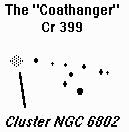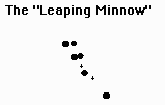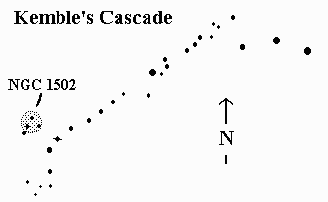The Asterism Game
Jack Kramer
From an official standpoint, an asterism is a sort of non-object; that is, it's a grouping of stars that appear sufficiently near each other in the sky so that we tend to associate them with one another. They may or may not be related in terms of their position in space, age, or gravitational interaction. For example, the "Coathanger Asterism", also known as "Brocchi's Cluster", in Vulpecula is a true open cluster, designated as Collinder 399 (Cr 399). In the sky it appears with an upside-down coathanger shape just to the northwest of the familiar arrow-shaped constellation, Sagitta. It's small and not easily seen unless the sky is sufficiently dark, but it's an excellent object for binoculars. The first time I noticed it was not in the sky, but rather on a photograph I had taken of the area about eight years ago.

At the eastern edge of Cr 399 is the 8.8 magnitude open cluster NGC 6802. The brightest members of this cluster are 14th magnitude, which explains why it appeared simply as an irregularly-shaped hazy spot in the 10" scope from my backyard.
On the other hand, there's the "Leaping Minnow" asterism in Auriga, located about 4o east of the star 3 Auriga; it's a prominent little grouping composed of the stars 14, 16, 17, 18 and 19 Auriga. Although it's located in an area full of open clusters and diffuse nebulae, the Minnow is not itself a true cluster - just a chance juxtaposition of stars seen as a slightly arched line that could remind one of a fish jumping out of water. I first noticed this asterism while aimlessly wandering the sky with a copyscope.

The two objects cited above are perfect examples of star petterns known as asterisms. In some cases where they've been designated as clusters, there is disagreement as to whether they are, in fact, true clusters. The Saguaro database, for example, shows some objects cataloged as clusters, yet the comments field indicates that this is questionable with the notation "asterism?" But asterisms in general are small, tight groupings that prompt us to feel that from our perspective, the stars ought to be related.
Some have been given fanciful names that reflect how they appeared to certain observers. One called "Kemble's Cascade" was named after the observer, Lucien Kemble, who called attention to it. This asterism is located in the constellation Camelopardalis, and it appears as a long string of stars beginning near the 8th magnitude cluster NGC 1502. The coordinates of the cluster are 4h07.7m, +62.2o. Here's roughly what it looks like:

Checking my records, I've observed NGC 1502, but there's no mention of having seen the Cascade. However, I observed the cluster from my backyard with the 10" scope and an eyepiece that gave a field of about .8o, while this asterism spans a distance of about 3o. So you'd need a wider field to notice it readily. This is an ideal object for binoculars or a wide field telescope. Once this area of the sky is better positioned, I intend to check out Kemble's Cascade with the copyscope.
Of course, an asterism need not have an unusual shape; it could be just a formless group of stars. (Some undiscovered possibilities: Garza's Glob? Barlow's Blob? Andree's Aglomeration?) In all cases, they're great objects for binocular users or those who have a small, wide field telescope. Sometimes when we run across one unexpectedly, there's a thought that maybe we've discovered another cluster. This sends us to a star chart to check it out. The chart may not even show the stars, and if shown, they may not be identified in any particular way. For example, the Tirion Sky Atlas 2000 shows the Coathanger stars with no designation. The more detailed Uranometria identifies the group as a cluster, with both common names.
Here's an example of a personal "discovery". While
wandering with the copyscope in Coma Berenices, I came
across a group of eight stars arrayed in the shape of two
diamonds that suggested a greyhound dog running at full
stride - the star at lower left being the front paw, the star
farthest to the right the rear paw, and the brightest star being
the head. The group spans just over 1o and is about 15o east
of the star Beta Leonis. When I first spotted the asterism, I was
unable to locate it on any chart. On the next night, I finally
broke down and used the setting circles; this got me into the
general area in the Uranometria, where I found the asterism
pictured at RA 12h46m, DEC +13.5o. The stars range between
7th and 9th magnitude. One problem is that the increments
used in sizing the star images on charts often don't represent
how they actually appear in the sky, and you also have to bear
in mind how the image in your scope is turned upside-down
or right-to-left. The galaxies in the field, NGC 4659 and
4689, are 13.3 and 12.8 magnitude, respectively, so they
weren't visible in the copyscope from my backyard.

The finding of asterisms is not something you accomplish by poring over star charts. It's a real observer's undertaking where you have to get out under the night sky with some wide field optical aid and just start sweeping. For those who presently use only binoculars, it helps you to learn your way around the sky and you could become real asterism experts. If you find a grouping for which there doesn't seem to be any official designation, well then name it after yourself! Often the astronomy press will mention a particular asterism with an obscure name, so another observer has already beaten you to that group. But with all those stars up there, think of the potential asterisms you could claim as your very own!
Published in the April 1994 issue of the NightTimes




